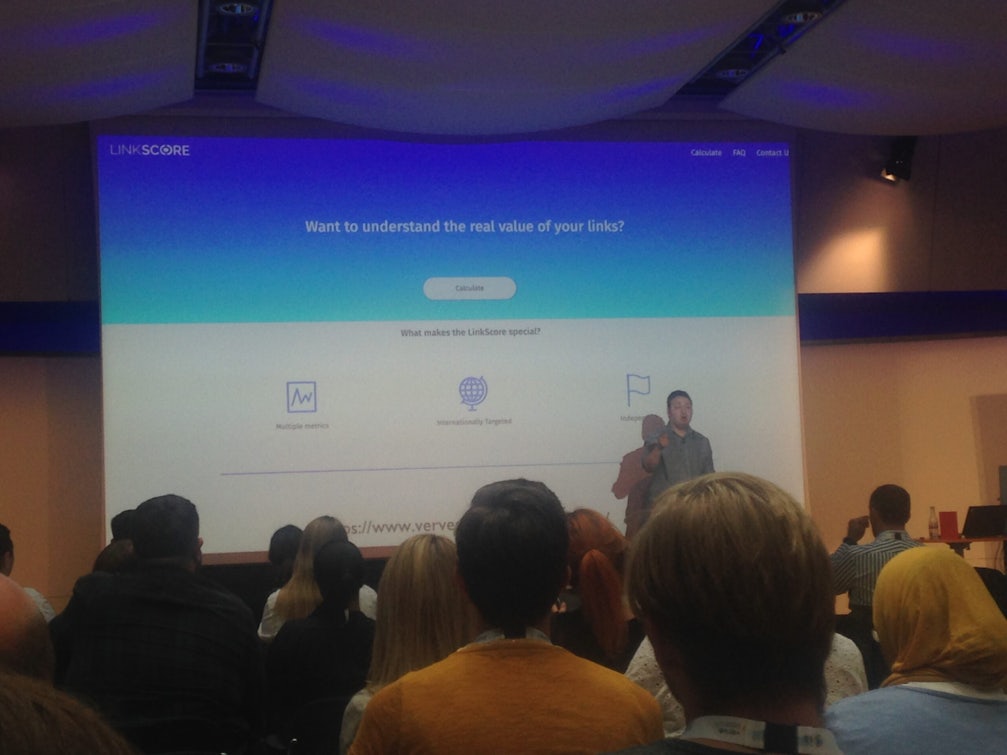The burning passion we all share, says James, is metrics.
Let’s start with one link, he says. His campaign achieved one link from The Guardian, and 32 from other sites around the web. Which link, he asks, is worth more? And which way that we report links makes either look better?
There are plenty of websites out there, so getting a quantity of links should be no problem. Most people view around 89 websites per month; if we viewed 89 websites per month for our whole lives, we’d only see 0.0001% of the websites out there – and chances are, we’re viewing the same websites again and again too.
So why, argues James, would we value quantity over quality?
The majority of the internet’s traffic, he says, goes to 73 websites. 73! That’s how small the internet actually is. So chasing numbers is a fools game if we want to be seen for anything worthwhile.
But with that said, if we only want the link from The Guardian so it gets read, does that mean that outreach is just PR that works online?
And if so, isn’t outreach just crappy PR?
In 2008, Google talked about brands being a solution. When Panda came out, Google was able to show how it would devalue the websites which consistently produced poor quality content, and it’s through this that it is moving toward refining its results to show those sites that are:
- trusted
- authoratative
- have high readerships
- have links from other high quality brands
The problem is that we’re not usually judged on our ability to build reputation. The way we report hasn’t really changed in 20 years, and we’re still reporting on how we are asked to work – focusing on numbers of links over quality
So we’ve tried to remedy that by integrating metrics like DA or DR – trying to build links that are of a DA:30 or higher. The only thing we achieve here is that we reduce the number of links we can build.
James therefore ran a study where he looked at 10,000 high ranking sites and was able to correlate high DA/DR with high ranking sites.
But when he flipped it and asked if DA/DR could predict the ranking positions of websites for a query, it simply couldn’t. You can check out his data here:
https://www.vervesearch.com/blog/seo-metrics-study
It turns out, we’re looking at just 1 or 2 metrics, knowing that Google is looking at hundreds of metrics.
LinkScore
Verve have therefore been working on a way to measure the value of links and have a platform which measures more than a dozen link metrics. They’ve been testing it for 5 years and they have managed to build something which does correlate with how sites rank:
The way this works is that it is able to pull in metrics from different tools depending on which metrics are most relevant. The first thing they did was increase the scale, to 0-500 instead of 0-100. This meant there was a better distance between a site like the BBC (DA:94) and one like the Verve site itself (DA:43). On LinkScore, the difference is much greater, so you can see what was most valuable to your campaign.
Quantity of links doesn’t tell you anything. If you can report on quality of links, you have a much better metric. So one link from the BBC is worth infinitely more than links from a crappy blog.
They also take into account language. If you achieve a link from a Russian language page but are a British brand, it’s seen as lower value than a local page.
Relevancy is also taken into account. It looks not only at how closely tied the content is to your brand, but also to how Google sees your site – so you’d rather have a link from a DA:40 than one from a DA:60 with a site wide penalty.
At Verve, they use the tool to review the potential value of a link before they go after it. That’s not to say they don’t go after those no followed links or lower value links to the potential to snowball, but they can be more prescriptive.
They also use it as a way to set clear goals. They report on LinkScore rather than number of links, so they’ll set a goal of a LinkScore of 3,000, then show how they perform, rather than a number of links.
People think we have control over rankings and sales, but we really can’t. The only thing we can actually control is the links you control.
We’re increasingly being asked to look at social shares and brand awareness. But if we have a client who we’ve done a lot of work for and then they do something that demolishes their reputation, we can influence it but we can’t control it.
The one thing you can control is the links that you build
By concentrating on that one thing, those things outside of our direct control look after themselves (and are part of the broader business’ remit). Check out LinkScore for more.



